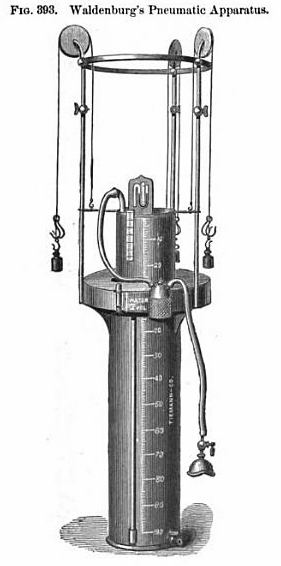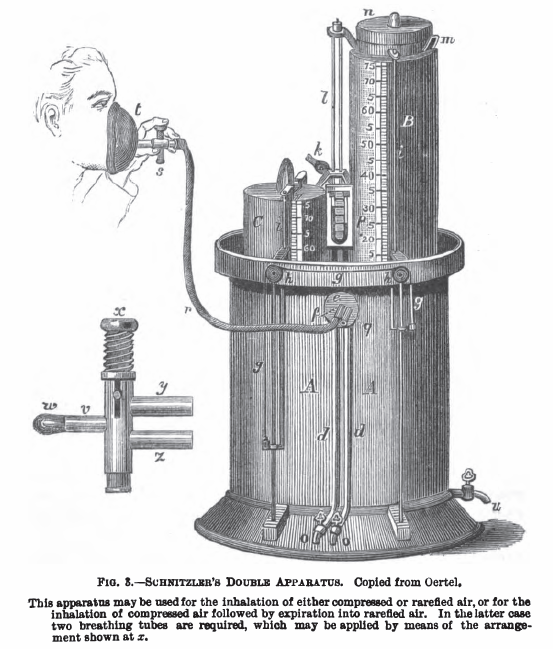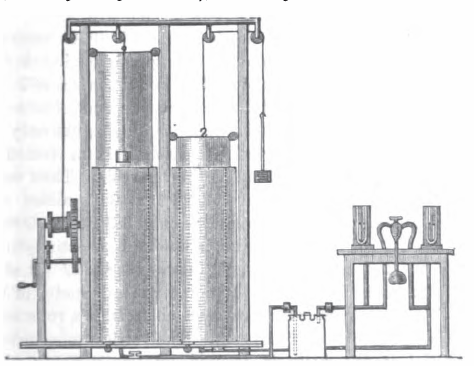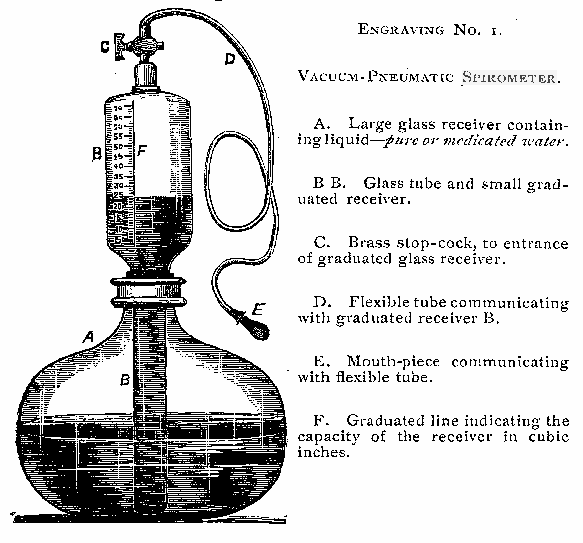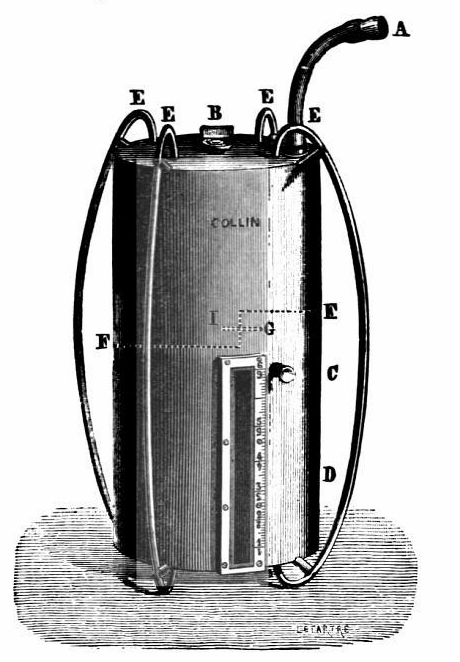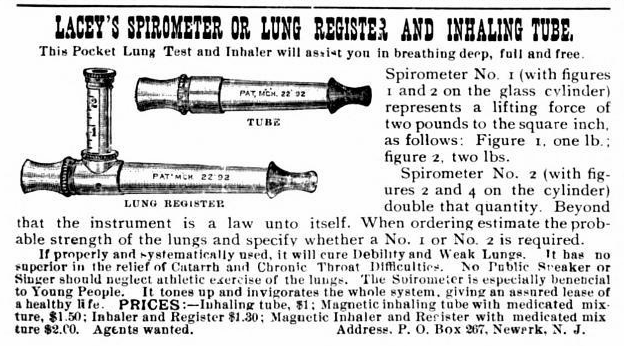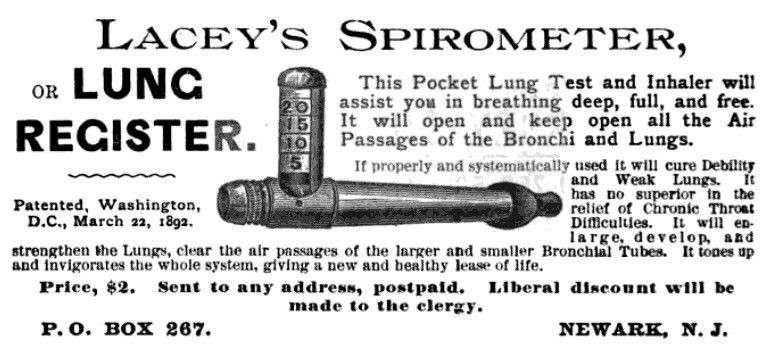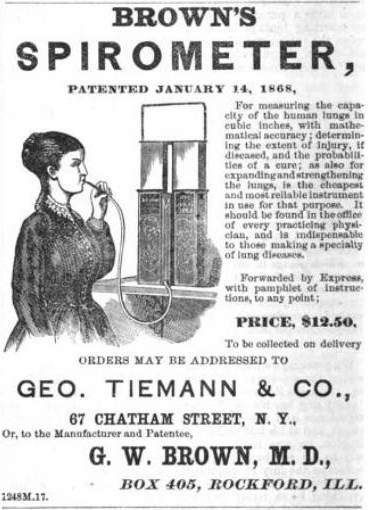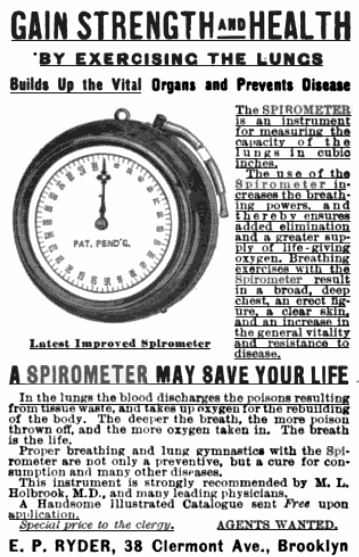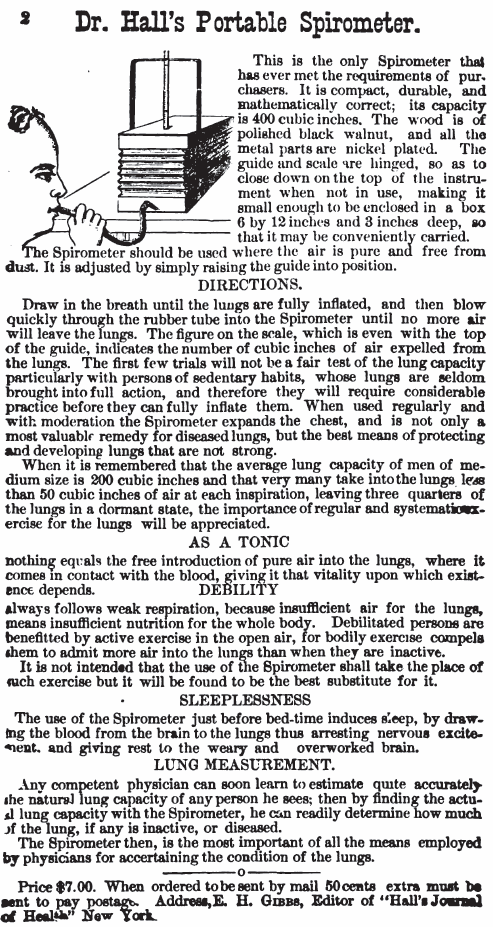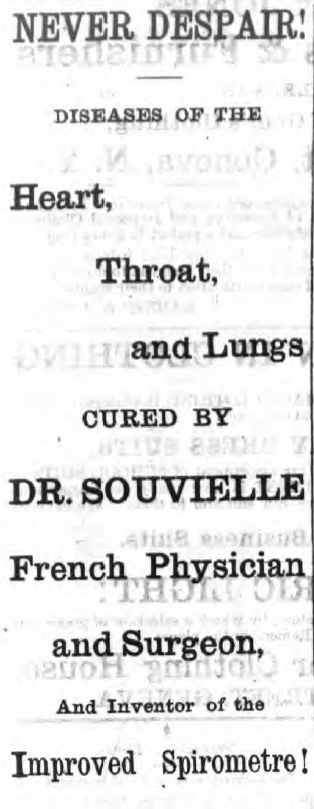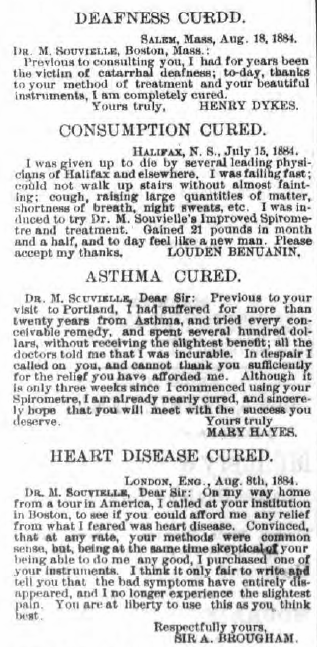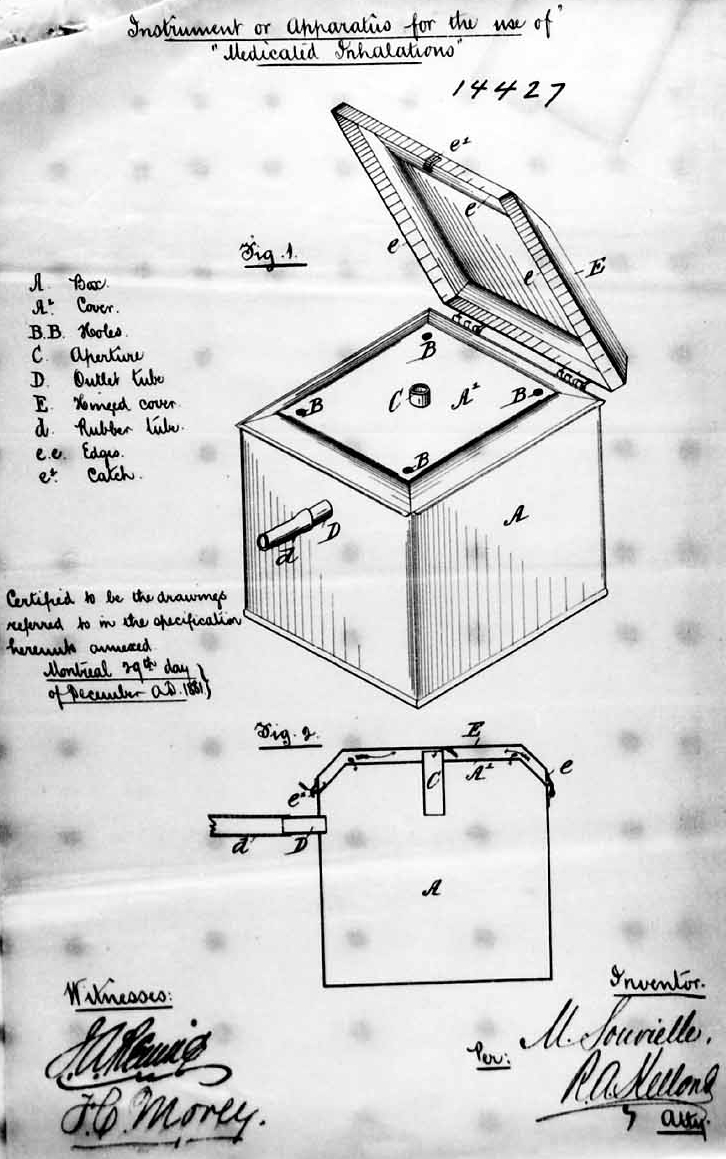During the 1800’s and the first part of the 20th century lung diseases such a tuberculosis, asthma and bronchitis were poorly understood and there were no effective medical treatments. Prominent physicians, inventors, well-meaning laymen and quacks all at one time or another proposed the use of spirometers as a way of treating lung disease.
In 1875 Dr. L. Waldenburg wrote an extensive treatise (“Die Pneumatische Behandlung der Respirations und Cirkulatationskrankheiten im anschluss and die Pneumatometrie, Spirometrie und Burstmessung”) on treating lung disease with compressed and rarified air. In this instance a spirometer was modified with weights to provide rarified air. From: George Tiemann and Co. Catalog, The American Armamentarium Chirurgicum, 1879, page 99.
Scnitzler’s apparatus is based on Dr. Waldenburg’s original device and was able to provide compressed and rarified air from the same instrument. From “The Inhalation Treatment of the organs of respiration including Consumption”, by Arthur Hill Hassal, MD. 1885. In the text of the book Dr. Hassal indicates that this treatment has been found harmful to patients.
A large-scale version of Waldenburg’s spirometer. From Von Ziemssen’s Handbook of general therapeutics, Volume 3, Translated by Elder Smith, 1885, page 389.
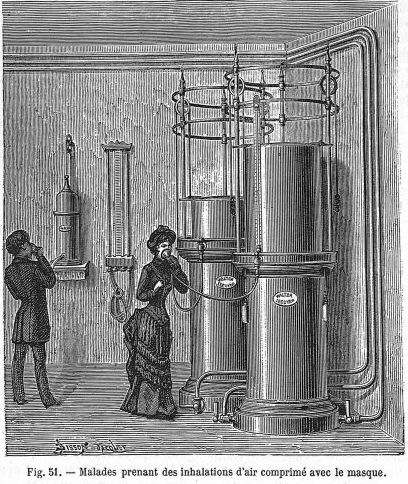
Compressed air, 1887. Before there were oxygen bars there were compressed air bars! Compressed air was a therapy championed by Waldenburg but even during his time it was severely criticized. Compressed air was stored in gasometers and then delivered by mask. From Dictionnaire Populare de Medicine, Volume 1, published by Flammarion and Marpon, Paris, 1887, page 52.
A much simpler device based on Waldenburg’s pneumotherapy was developed by Dr. Joseph W. Jones. It applied both pressure and vacuum for the treatment of lung disease. From: Transactions of the Louisiana State Medical Society, Volume 10, 1888, page 221.
Not so much treatment device but one to exercise the muscles of the lung. From “On respiration in singing” by Joseph Joal, Published by F.J. Rebman, 1895, page 84.
“…this instrument has a double Mariotte’s vase, composed of two chambers, placed over one another and separated by two semi-circular diaphragms, F H, which are joined by a vertical septum. The two chambers are put into communication by tube I. The apparatus being half full of water, and the liquid filling the upper reservoir, if we breathe by the mouthpiece A, a quantity of water is displaced, and flows out of the upper reservoir, into the lower one; the graduated glass permitting us to determine the level of the liquid.
“When the upper chamber is empty it suffices to turn the instrument upside down, corking the tube E, and placing the mouthpiece on the chamber D, at the same time that we raise the screw C, and close the opening C.”
Lacey’s Spirometer, 1892. Another exercise device. From The Minutes of the 33rd Session of the Des Moines Annual Conference of the Methodist Episcopal Church, published by Herald Printing House, 1892, un-numbered page about mid-volume.
Lacey’s Spirometer, 1897. From The Minutes of the 1897 Session of the Newark Conference of the Methodist Church, Page 150.
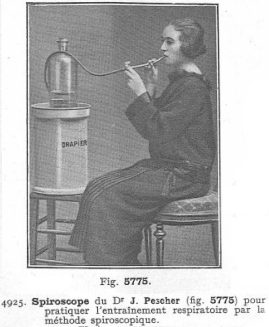
Dr. J. Pescher’s Spiroscope, 1929. A water spiroscope meant for respiratory exercises. From a Drapier et Fils Medical Supply catalog, 1929, page 26. Found on the Medic Database.
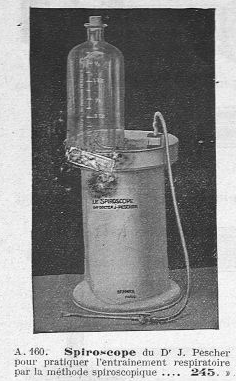
A closer view of Dr. J. Pescher’s Spiroscope. From a 1933 Guillot Medical Supply Catalog found on the Bibliotheque Interuniversitaire du Sante website.
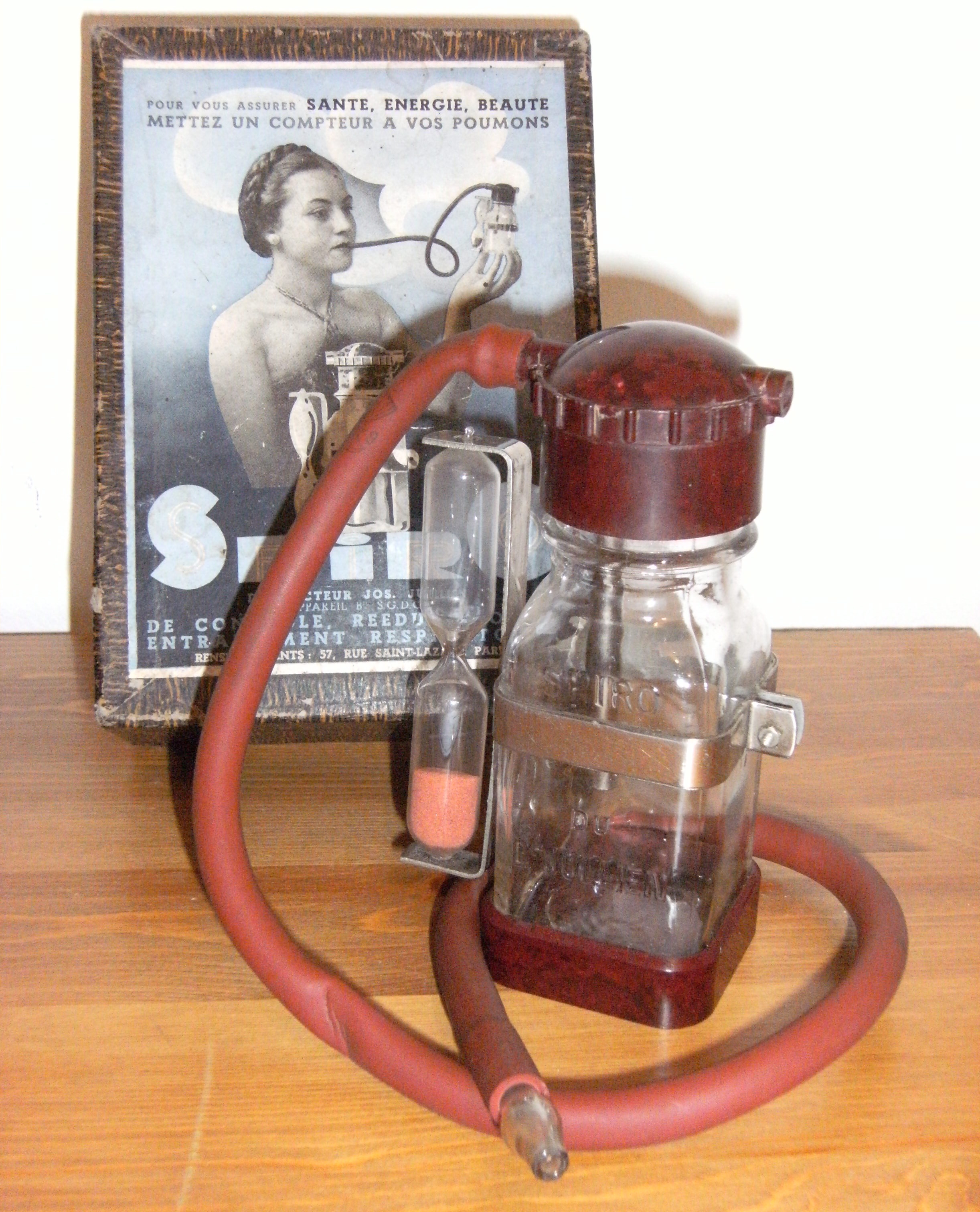
Dr. Jos. Jullien’s SpiroScope, 1934. Dr. Jos. Jullien was a noted French physician and researcher who studied and treated brucellosis. He developed and patented a respiratory exercise device called the water spiroscope in 1934. It was commercially marked in 1936 by a group of insurance companies. Photo was kindly provided by Laurent Jullien, a descendent of the Dr. Jullien.
In his patent application Dr. Jullien stated (via Google translate): “The spiroscopes presently known can be divided into two categories: 1) The spiroscopes which operate on the principle of gas holders or those that operate on the principle of communicating vessels, present a significant incumbrance; a large body of water (6-7 liters) is required to run and are consequently little easily transportable; 2) The pressure gauges spiroscopes to offer significant resistance to exhalation, which results in errors in the measurements; Moreover, these devices are expensive and delicate maintenance. “… This innovation is intended to overcome the above drawbacks; it relates to a Spiroscope characterized by a conduit expired air discharge opening freely in a liquid bath,
controlling the rate of expiration, while a movable indicator member controls the duration of expiration, thereby measuring the volume of expired air and the duration of exhalation. ”
The leaflet provided with the spiroscope said (via Google Translate): “Fill with water to half the bottle: First time. Aspirate slowly and deeply through the nose (as it sniffs a flower). 2nd time. Hold your breath, take the glass between the lip tip at the end of spiro tube. Reverse the hourglass, sand above. When the sand runs, blow gently and steadily in the tube, without stop, by setting the exhaust air bubbles on the flow of the sand. 3rd time. Stopping short of breath, leave the unit for a time equal to the second time, breathing plenty (suck through the nose, blow through the nose). Rate each blowing the amount of blown sand. You control well and increase your respiratory capacity and ventilate up your lungs.”
Further information (also provided by Laurent Jullien) on Dr. Jullien can be found at:
1. Laurent Jullien, Le SPIRO du docteur Jos Jullien, Clystère, n° 51, p. 28-45, juin 2016.
2. Laurent Jullien, Le Spiroscope à eau du médecin-artiste Jos Jullien, de la médecine au bien-être, La Nouvelle Cigale uzégeoise, n°12, p 11-16, Lucie éditions, Nîmes, décembre 2015.
There is no explanation how this device worked. At a guess, it appears as if the balance arm was placed in front of an individual’s lips and they blew on it. From The Esoteric, Volume 3, Number 12, an Advertising page at the front of the issue.
Brown’s spirometer, a water-seal spirometer with a rectangular bell. Advertised as something between an actual spirometer and a way to exercise and develop thje lungs. From: The Medical Gazette: A Weekly Review of the Medical Sciences, Volume 5, edited by H.W. Turner, 1870, page 134.
The Simplex spirometer used a turbine and clockwork mechanism. It sold from around 1900 through the 1920’s. Later advertising toned down the claims made in this advertisement. From the Phrenological Journal and Science of Health, Volume 111, No 4, April, 1901. Un-numbered front page.
Earlier advertising was even more hyperbolic. From: Hall’s Journal of Health, Volume 26, March, 1879, Frontispiece III.
The longest-lived of this type of spirometer was the Barnes Spirometer which was first invented in 1865 by Aaron P. Barnes and was still being advertised and sold much the same way up until 1920. This advertisement is from The Herald of Health, 1875, January issue, page 93.
A description of the Barnes spirometer from: The Science and practice of medicine, Volume 2, 1866, By William Aitken, page 563: “The Lung Tester of A.P. Barnes (to be had of Messrs. Codman & Shurtleff, Boston) is the simplest and cheapest of all spirometric instruments. It consists of a cylindrical bag of India-rubber cloth, closed at each extremity by a disk of wood, and furnished with two metallic tubes; one tube enters laterally at the bottom, and is about three inches long; the other, vertical, is about twelve inches long, and graduated, and inserted in the centre of the upper disk. A flexible tube of proper length, with a mouthpiece is stretched over the outer aperture of the lower metal tube, and through this a forced expiration is made; the expired air fills, more or less, the bag and the vital capacity is recorded on the upper tube, which is forced up as the bag expands. The bag is enclosed in a tin cylinder, shut at both ends with two holes for the tubes.”
The most outrageous claims were made by Matthieu Souvielle, a Canadian con man par-excellence. His “spirometer” cured everything and he had the testimonials to prove it. Here are two parts of a full-column ad from a Geneva, NY newspaper from 1880.
Even more outrageous than the claims he made is that while the other spirometer manufacturers at least made a pretense of measuring exhaled lung volume Souvielle’s device was nothing more than a box with two holes (which he was somehow able to patent!):
Souvielle made tens of thousands of dollars (a fortune at that time) and did this not only by preying on the people that bought his treatment but by bilking a number of people that had invested large sums of money in his business venture of building and selling “spirometers”. Souvielle eventually moved to Florida to escape his creditors and was never prosecuted.

PFT History by Richard Johnston is licensed under a Creative Commons Attribution-NonCommercial 4.0 International License.
